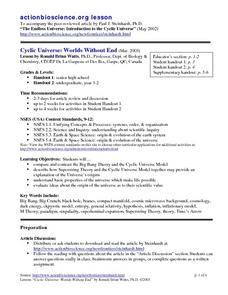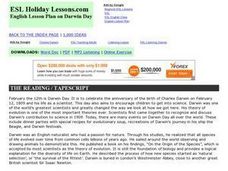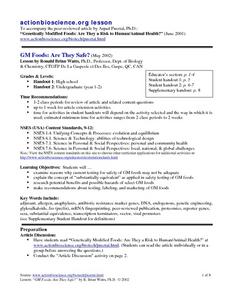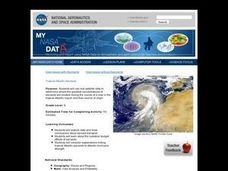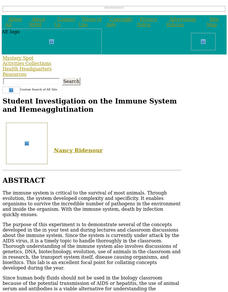Curated OER
Where Do I Belong?
Tenth graders study the diversity of life in the world. They classify and sketch organisms into the 6 kingdoms.
Curated OER
Can You Beat Jet Lag?
Learners examine the health condition of jet lag. Using mealworms, they test the effect of light on the development of them into adults. They answer discussion questions and examine the relationship of age and one's activity level.
Curated OER
Cyclic Universe: Worlds Without End
Students compare and contrast the Big Bang Theory and the Cyclic Universe Model. They explain basic properties of the univers which make life possible. They evaluate ideas about the origin of the universe as to their scientific value.
Curated OER
Darwin Day
For this Darwin Day worksheet, students read or listen to a tape passage about Charles Darwin, then match phrases, fill in the blanks, choose words, unscramble words and sentences, put sentences in order, write discussion questions and...
Curated OER
The Chordates
Students study the characteristics of organisms that are a part of the phylum Chordata. In this organisms lesson students identify mammals that are native to Saskatchewan.
Curated OER
Wild Kingdom
Students research and discuss the natural habitats and various evolutionary theories of giraffes and other animals imported into ancient Rome.
Curated OER
Trouble in the Troposphere
Students create graphs using NASA data, compare ozone levels of several U.S. cities, analyze and evaluate the data and predict trends based on the data, and discuss and describe how human activities have modified Earth's air quality.
Curated OER
Half Life Lab
Seventh graders model radioactive decay using pennies, collect data from their model, apply scientific visualization techniques to their data and create animated models explaining the concept of radioactive half-life.
Curated OER
Galapagos Project
Young scholars explore Darwin's trip to the Galapagos Islands. In groups, students create a field guide for one of the five major islands in the Galapagos.
Curated OER
GM Foods: Are They Safe?
Students examine the process for testing GM foods. They research benefits and hazards of a selection of GM foods. They also create images of new labels and marketing for GM foods.
Curated OER
Seasonal Cloud Cover Variations
High schoolers recognize different cloud types. They determine the seaonality of various types of clouds. They graph the data and determine if a correlation exists between season, cloud cover and type of clouds most prevalent during each...
Curated OER
The Challenge to Deliver Insulin
Students investigate these fundamental chemical and cellular processes. They recognize the long-term danger that comes from a diet of fast food, chips, and soda, realize that avoiding diabetes is their responsibility, and establish...
Curated OER
Animal Adaptations
Tenth graders participate in an arthropod scavenger hunt. In groups of two, they identify and collect two specimens of arthropods in the school area, and create a table of all the specimens and what class they belong to.
Curated OER
Hominoid Skull Comparison
Students are provided with evidence used to support evolutionary theory. They are introduced to classification by using primates as an example. Students read article related to Hominoid Skull Comparison and write a summary about the...
Curated OER
Troical Atlantic Aerosols
Students explore the effect aerosols have upon he weather and climate. They observe NASA satellite images to explore and draw conclusions about aerosol transport. From studying the images, students track the path of aerosols. They...
Curated OER
Linkages Between Surface Temperature And Tropospheric Ozone
Students collect and interpret data to make predictions about the levels of ozone in the atmosphere. Using the internet to collect data students use their collected data to create a line graph for analysis. Students make mathematical...
Curated OER
Trouble in the Troposphere
Students Use data sets from MY NASA DATA to produce graphs comparing monthly and yearly ozone averages of several U.S. cities. They analyze and evaluate the data and predict trends based on the data. In addition, they discuss and...
Curated OER
Basic Genetics
Ninth graders discover where their physical appearance and personality traits come from. In this genetics lesson, 9th graders learn about cells, chromosomes, DNA and genes. Students discover where genes come from as well as dominant and...
Curated OER
Idioms Quiz: Clothing 2
In this English idioms worksheet, learners interpret the meaning of various idioms based on clothes and clothing. Students complete sentences using the meanings of the idioms.
Curated OER
Saving Tropical Rainforests
In this rainforest worksheet, learners watch a video of Prince Charles wanting to save the tropical rainforest and then fill in the blanks to sentences about the video. Students complete 12 sentences.
Curated OER
The Chromosome Connection
Learners evaluate the degree of chromosome similarity and difference between humans and apes. Students infer about the relationship between a human and ape based on similarities found.
Curated OER
Communication in Bees
Eighth graders identify and interpret a scientific investigation and a hypothesis through experimentation and testing a hypothesis. They identify what scientists hypothesized about the communication of stingless bees. Finally, 8th...
Curated OER
Inquiry and the Nature of Science
High schoolers identify questions that can be answered through scientific investigations, design and conduct a scientific investigation. They also use appropriate tools and techniques to gather, analyze, and interpret data.
Curated OER
Student Investigation on the Immune System and Hemeagglutination
Learners study laboratory protocol for hemagglutination experiments.




